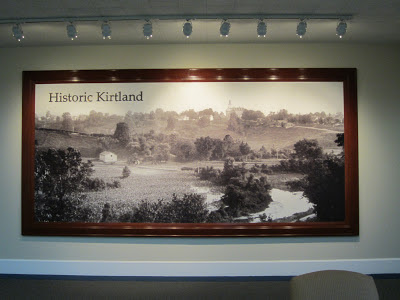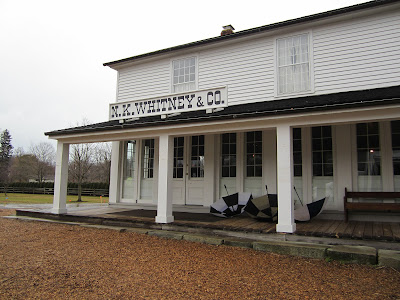Informational card handed out at the Visitor’s Center, Kirtland, Ohio
Reverse
If possible, I like to visit historic sites, churches, cemeteries, archives, museums, parks, candy factories, flower gardens and things like that when I travel. While I was visiting my son and his family in Ohio earlier this year we took a day trip to visit Kirtland one of the Mormon historic sites. Several houses, the sawmill, the ashery, and the Whitney general store have been rebuilt to look as they did in the 1830s when the Latter-day Saints lived there. All of the furnishings date from that time period and a few even originally belonged there. Others are antiques that were purchased and put in the houses as part of the restoration. The attention to historical detail is amazing. There is also a very nice modern visitor’s center on the grounds with old photographs on display in the lobby and a small theater that shows a documentary film about the church in Kirtland.
Visitor’s Center, Kirtland, Ohio
One of several photos on display in the Visitor’s Center, Kirtland Ohio
The Mormons were a small religious group founded in upstate New York in
1830 and forced to move westward from place to place until they
eventually ended up in Salt Lake City, Utah in 1847. Kirtland, Ohio was
one of the communities where they lived for a short period of time
before moving on. The early members of the church suffered much
persecution because of their beliefs. Today the church membership is
about 14 million worldwide and is perhaps best known for its Tabernacle
Choir.
The Newel K. Whitney Store
Tour guides and the interior of the Whitney store
If one wishes to go into the restored buildings on the grounds at Kirtland it is necessary to take a guided tour so we did that too. Our guides were two very nice sister missionaries who gave us a lot of historical information as we went from building to building. After we completed the tour we walked up the hill to see the Temple that is still standing but now belongs to the Community of Christ. Apparently it is possible to take tours of the inside of the old Temple but since it was winter the hours of operation were limited and we were not there on the right day or the right time to do that. Nevertheless we did walk around the grounds.
The Kirtland Temple
Part of the fence near the Sawmill
Stonybrook, part of the Chagrin River, and the sawmill
From time to time the brook was dammed and a pool was allowed to form so that baptisms could be preformed in it.
Part of the sawmill was set aside as a carpentry area where pulpits like these were made for the Temple.
Inside the store there was a checkerboard set up with the board painted on the table and the pieces made of slices of dried corncob.
Living quarters above the store
Other restored buildings
An ironing board constructed of two chairs and a board
Family bedroom with double bed and trundle
Workbench with tools
The ashery
The Ashery is where ashes were converted to make lye water, potash and pearlash. The lye was made by soaking the ashes in tubs or barrels of hot water. Potash looked like dark lumpy rocks when further refined the resulting pearlash was white in color. Pearlash was used to make glass and ceramics, potash and lye water for manufacturing soap. Potash with saltpeter was used to make gunpowder. The Ashery employed people, made products for the community and also to sell. It used or recycled ashes even producing its own ashes during the refining process. An abundance of local timber provided the necessary wood.
One of the barrels where the ashes were soaked in hot water to make lye
Looking in the oven at the end product, pearlash
For more information see http://www.mormon.org






















No comments:
Post a Comment